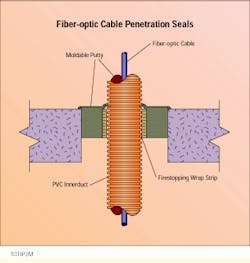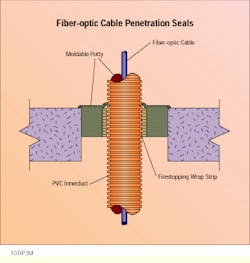Firestopping fiber-optic cable penetrations
Dan Silver,
3M Telecom Systems Division
Problem
Fiber-optic cables are typically encased in polyvinyl chloride or polyethylene innerducts that protect the cables from damage during installation. When you install fiber-optic cable enclosed by PVC innerduct through walls or floors, you must ensure that the penetrations, or holes, meet the American Society of Test and Measurement E814 standards of two-hour "F" and "T" ratings.
Solution
To meet the appropriate fire ratings, you can block the passage of flame through the penetrations in the floor (or wall) with an appropriately rated firestopping material and, at the same time, form a smoke seal inside and around the cable`s innerduct. Remember that firestopping materials for wall penetrations must be installed on both sides of the wall.
Procedure
Note: This firestopping procedure is for PVC innerducts that contain a maximum of 24-fiber PVC-jacketed fiber-optic cables and are 1.25 inches in diameter.
1) After the cable has been installed, wrap a single layer of firestopping wrap strip, foil side out, around the 1.25-inch diameter PVC innerduct.
2) Secure the wrap with 16-gauge steel tie wire, making sure that the top of the wrap strip is even with the surface of the floor or wall.
3) Pack the remaining space--between the wrapped innerduct and the floor/wall--with firestopping putty to a 2-inch depth. This will seal the interface between the wrap strip and the innerduct.
4) To complete the smoke seal, install a plug of putty inside the innerduct.
Use the same procedure for polyethylene innerduct; however, use two firestopping wrap strips instead of one (see step 1).
Use a firestopping wrap strip and moldable putty to fill the holes made by installing innerduct-enclosed fiber-optic cable through floors or walls.
Dan Silver is market manager, local area networks, at 3M Telecom Systems Division, Austin, TX.

